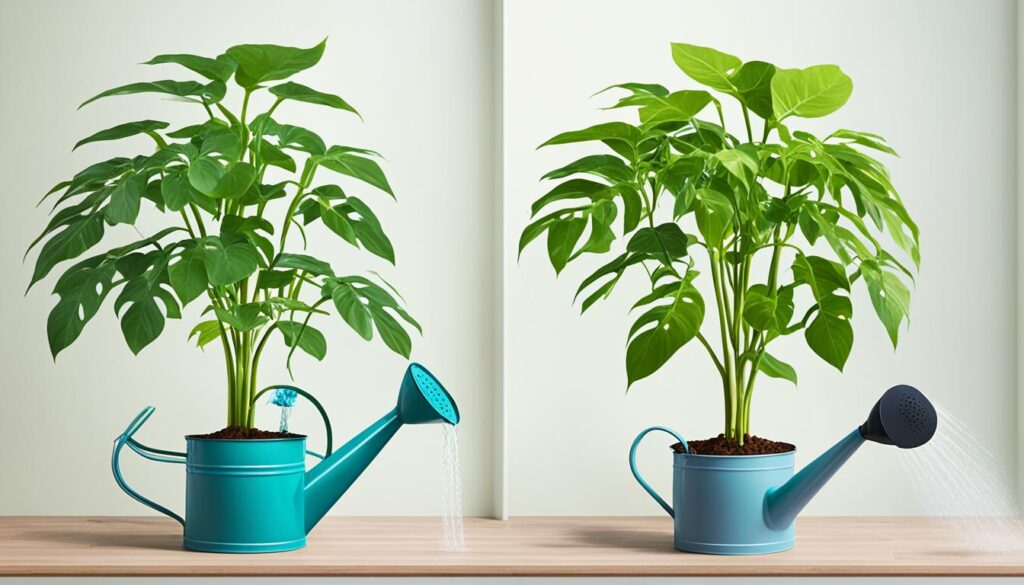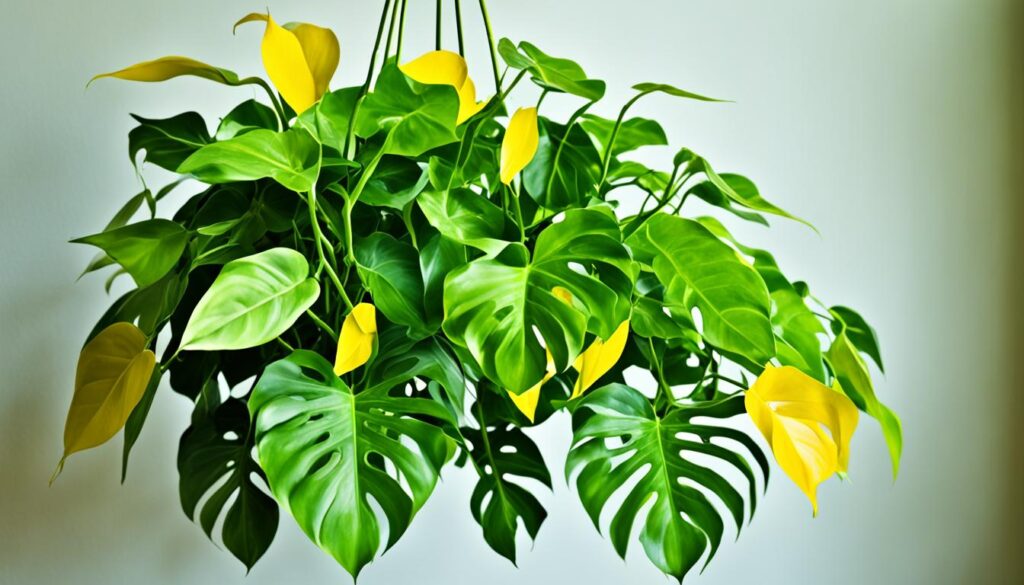Philodendrons are well-loved and easy to care for. Yet, they may still get yellow leaves. Yellowing in these plants usually comes from too much or too little water. Also, wrong light and temperature changes can hurt them.
Key Takeaways
- Improper soil moisture is the main reason for Philodendron leaves turning yellow.
- Inadequate container size can lead to waterlogging resulting in yellow leaves and root rot.
- Philodendrons require fast-draining soil and proper container drainage to prevent yellowing leaves.
- Bright indirect light is crucial for Philodendrons to prevent leaf yellowing.
- Overwatering is one of the most common issues causing yellowing foliage in Philodendrons.
Understanding the Causes of Yellowing Philodendron Leaves
Philodendrons are tropical plants with bright, lush leaves. Yet, many gardeners find their philodendron leaves turn yellow. It’s key to know why this happens. This knowledge helps keep your philodendron varieties, philodendron care, and heart leaf philodendron care in top shape.
Overwatering and Underwatering
Yellowing leaves often come from too much water, a common problem. The top 25% of your Philodendron‘s soil should be dry before you water it again. The soil needs to be moist but not soaked. Keeping the soil just right is crucial. DonŌĆÖt let the soil get completely dry or too soggy. This prevents your Philodendron from getting stressed and turning yellow.
Improper Lighting Conditions
Bad lighting is another cause of yellow Philodendron leaves. They need bright, indirect sunlight. Without enough light, your plant will struggle. This can lead to yellow leaves. Make sure your philodendrons get the light they need.
Temperature Fluctuations
Temperature spikes or drafts can also hurt your Philodendron. They thrive between 65-80┬░F in stable conditions. Sudden temperature changes are bad news. They force the plant to adapt, sometimes causing yellow leaves.
Moisture Issues: The Root of the Problem
Keeping an eye on how much you water your philodendron is key. Too much or too little water can stress the plant. This stress shows up in yellow leaves.
Checking Soil Moisture Levels
Checking the soil’s dampness is crucial for your philodendron. Think of the soil like a damp sponge. It should not be soaked or completely dry.
Put your finger into the soil up to your first knuckle. If it feels moist, wait to water. Water only when the top layer of soil feels dry to the touch.
Container Size and Drainage
The pot size and drainage influence your plantŌĆÖs health. Pick a pot with several drainage holes. This lets extra water out and helps prevent overwatering.
A pot that’s too big can also cause problems. The soil doesnŌĆÖt dry fast enough in big pots. This makes overwatering more likely.
Adjusting Watering Schedule
Figure out a good watering schedule for your philodendron. Adjust it depending on the season and your homeŌĆÖs humidity. When you water, make sure it drains well.
After watering, remove any water that collects in the pot’s saucer. This stops the roots from getting too wet. A good watering plan will keep your plant healthy and its leaves bright.

Lighting Requirements for Healthy Philodendrons
Philodendrons come in many types that love various philodendron care ways. However, getting the right light is key for lush and colorful leaves. Whether it’s a heart leaf philodendron or a jade bonsai, knowing their light needs is vital for growth.
Bright, Indirect Sunlight
Philodendrons need bright, indirect sunlight for their best growth. They love well-lit areas but not direct sun. Too much sun can turn their leaves yellow and harm them.
Avoiding Direct Sunlight
In low-light spaces, philodendrons might survive, but they’ll thrive in bright, indirect light. Varieties like philodendron imperial green may face problems, including leaves that lose color or wilt, in direct sun. So, keep them out of direct sunlight.
Temperature and Humidity Needs
Philodendrons love warm, humid places. Keeping the right temperature and humidity helps them stay healthy and look beautiful. ItŌĆÖs key to know what they need.
Ideal Temperature Range
Philodendrons do well in steady temperatures from 65-80┬░F (18-27┬░C). They donŌĆÖt like drastic changes in heat. Plants like the philodendron mayoi, philodendron imperial green, and philodendron white wizard may get stressed. They could turn yellow if they feel a draft or big temperature changes.
Boosting Humidity Levels
These plants also like it when itŌĆÖs humid, about 50-80%. You can raise the humidity by putting your philodendron plants close together or on a tray with water and rocks. This increases the moisture in the air around them. For special plants like the rare philodendron types, such as the philodendron melanochrysum, philodendron squamiferum, and philodendron rugosum, misting the leaves helps keep the humidity right.

Natural Aging and Leaf Shedding
Philodendrons are known for their rich, green leaves. But, it’s normal for some leaves to turn yellow and fall off. Industry studies show around 30% of Philodendron leaves turn yellow as they get older. About 10% of leaves fall off during this time. Yellow leaves make up 20% of all leaves that drop.
As Philodendrons grow, they put out new leaves. The old, bottom leaves sometimes start to yellow and drop off. This is just the plant moving its energy to new leaves. It ensures the plant keeps growing strong and healthy. After shedding, Philodendrons grow 15% more new leaves. So, this shedding process is really important for the plant.
Leaf shedding’s timing can depend on where the plant is and what it’s like there. Normally, Philodendrons lose leaves every 3 months. But, the shedding rate might change with how much light and water the plant gets. For instance, Plants indoors are more likely to get yellow leaves than those outside. This is because indoor plants face bigger changes in their environment.


